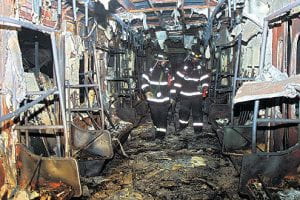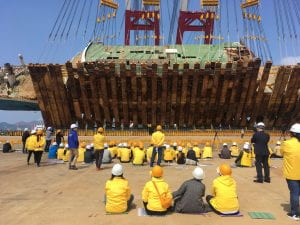On March 15, 2020, President Moon Jae-in of South Korea declared the Daegu Metropolitan City and some of surrounding areas of North Gyeongsang Province as a “special disaster zone.” Daegu became a hotspot of COVID-19 in Korea on February 18th, when COVID-19 case #31 was confirmed in the city. The carrier of the first case in the city was found to be a member of a secretive religious group called Shincheonji and, prior to testing for the virus SARS-CoV2, she had attended two weekend services along with a large group of members gathered in a cramped space. “#Patient31,” as the Twitterati has been referring to this person, had gone about her daily business, which brought her into contact with people in public spaces, bringing her estimated total number of contacts 1,160 people. The day following the announcement of COVID-19 case #31 in South Korea, tens and then hundreds of new cases were reported in Daegu and its vicinity. Residents of Daegu suddenly found themselves in the center of a rapidly developing epidemic disaster.

February 18th also marked the seventeenth anniversary of the 2003 Daegu Subway Fire. On the morning of February 18, 2003, a man committed arson within a subway car at a downtown station in Daegu that eventually killed 192 and injured 152. It was the largest train-related accident in Korea and is considered among one of the worst subway disasters in the world. Victims’ families as well as survivors still live with trauma from the tragedy. On February 18th this year, a memorial ceremony was held at the Daegu Safety Theme Park, a public facility for safety education established in the wake of the subway fire disaster. As could be expected, news about a disaster from seventeen years ago was completely eclipsed by the constantly updated numbers of COVID-19 cases from Daegu.
Few make explicit connections between the subway fire in 2003 and the COVID-19 epidemic in Daegu.

(Someone who did so told me about a similar fear of death and isolation in 2003 and 2020, which had never occurred to me.) One can only imagine, however, what the residents of Daegu who experienced or have the memory of the subway disaster are feeling as the entire nation, or even the world, labels their city as the most dangerous place to stay in. Thousands of Daegu residents entered self- or forced-quarantine for clinical reasons, of course, but this surely was accompanied by social and psychological isolation as well. Talk of “blocking” or “containing” Daegu started to appear, though Daegu remained open. As in the case of restrictions placed upon residents of Wuhan, China, any record of having recently visited or lived in Daegu justified flight restrictions. Meanwhile, many Daegu residents with confirmed COVID-19 had to stay home because there were not enough hospital beds for them. Several died while waiting to be admitted to a hospital. As of March 17th, South Korea has 8,320 confirmed cases of COVID-19, of which 74 % are in Daegu.
Disasters isolate people, but they can also connect people. Victims and their families of earlier disasters are often the first to reach out to the victims of any emergent disaster. The families of the Sewol ferry disaster victims in 2014 are one such group. The sinking of MV Sewol on April 16th, 2014, killed 304 passengers and crew (five of them are still missing officially), including 250 high school students on a spring school trip. Almost six years later, the official investigation of the Sewol disaster is still underway.

The 4.16 Sewol Families for Truth and a Safer Society, the official association of the Sewol victims’ families, has worked hard to raise awareness of the suffering of disaster victims and the COVID-19 news from Daegu made them act quickly. Last week, the Sewol families and related organizations raised more than 50,000 USD to send masks, hand sanitizer, and other supplies to medical personnel and vulnerable groups in Daegu. In addition, the mothers of two student victims sent hand creams and a thank-you note to nurses at a university hospital in Daegu (since frequent washing dries their hands.) In their note to the nurses, the mothers mentioned many dedicated volunteers who helped them back in 2014, when they were desperately searching and waiting for their missing daughters. In times of a disaster, people help other people, who will remember it and go on to help even more people.
The current COVID-19 crisis in South Korea is often compared with other public health crises such as the SARS in 2003 and the MERS in 2015 in terms of the scope and intensity of the epidemics and the effectiveness of government responses. If we look at it from the perspective of human suffering, trauma, and memory, however, COVID-19 also knits together other kinds of disasters in recent Korean history. In this sense, everybody has been affected by a long series of disasters. It seems that we are all in this together—as victims, as responders, and as fellow human beings.
Chihyung Jeon teaches STS (science, technology & society) at Korea Advanced Institute of Science and Technology (KAIST). He also runs the “Teach Sewol” website, a collection of teaching materials on the Sewol ferry disaster.
* * *
The Teach311 + COVID-19 Collective began in 2011 as a joint project of the Forum for the History of Science in Asia and the Society for the History of Technology Asia Network and is currently expanded in collaboration with the Max Planck Institute for the History of Science(Artifacts, Action, Knowledge) and Nanyang Technological University-Singapore.
![[Teach311 + COVID-19] Collective](https://blogs.ntu.edu.sg/teach311/files/2020/04/Banner.jpg)